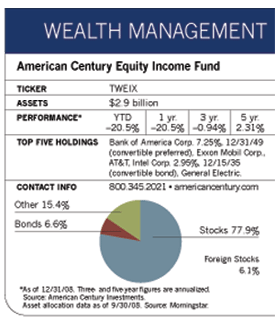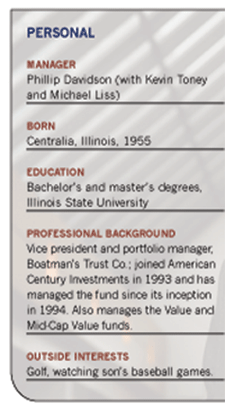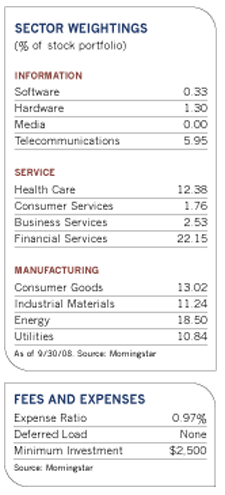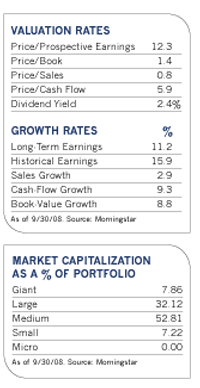Phil Davidson admits that most of the time, he likes to play it safe. The 53-year-old Davidson, who oversees value strategy investing at Kansas City, Mo.-based American Century, has been at the same company for 15 years and rarely misses work. He always bought used cars until last year, when he splurged on a new BMW. In his spare time, he enjoys a nice, relaxed game of golf or watching his son play baseball.
As an investor, he and a team of seven analysts gravitate to quality companies with solid balance sheets-a conservative and some might say boring strategy that in some years has produced yawn-inducing returns. American Century Equity Income, the $3 billion fund he has managed since 1994, missed out on the bounties of the dot-com boom in the late 1990s as Davidson and his team sidestepped expensive technology companies in favor of tamer fare. In 2006, the fund largely sat out the commodity boom because it was underweight in a roaring sector its managers deemed overpriced. In 2007, its returns trailed the S&P 500 Index by 3.7%.
Then there is the other side of boring: Davidson was able to even out the score in 2008, a time when investors quickly learned that, in the long run, losing less can mean making more. As the daunting year drew to a close, the fund had beaten the S&P 500 by more than 15 percentage points, even after a year-to-date loss of nearly 24% by mid-December. It was in the top 1% of its Morningstar large value peer group over the same period and also for the one-, three- and ten-year periods, and it was in the top 4% over a five-year period. On December 31, the fund narrowed its loss to 20.5% for the year while the S&P was down 34.06%.
While the American Century Equity Income fund's strong long-term numbers come largely from 2008 results, it is more than a one-year wonder, says Morningstar analyst Gregg Wolper in a recent report. "Even excluding this year's showing, it has been a fine performer overall since its 1994 inception, and lead manager Phil Davidson has been around from the start. It's certainly worth considering, as long as you don't expect it to consistently top the charts," Wolper notes.
The fund's strong showing against its peers last year was as much due to the stocks it didn't own as those that it did, says its manager. Even though it had nearly one-quarter of its assets in financial names, the fund's search for solid balance sheets helped it avoid the hardest-hit members of the group, including American International Group, Wachovia and mortgage lenders Fannie Mae and Freddie Mac. The fund also significantly underweighted metals and mining stocks because Davidson believed that earnings for the group were at peak levels and unsustainable. This strategy paid off when commodity prices fell later in the year.
Besides avoiding some of the year's biggest losers, the fund also owned several major health-care companies, such as Johnson & Johnson, that held up better than much of the entire market. The firm's individual stock choices also made their mark. In the third quarter, Rohm and Haas, a specialty chemical company, rose more than 50% on the news that it would be acquired at a substantial premium by Dow Chemical. Consumer staple holdings such as Campbell Soup and UST, the leading producer of smokeless tobacco products, also did relatively well.
Detractors from performance included financial services firm AllianceBernstein as well as Total S.A. and BP Plc., companies whose prices declined sharply near the end of the third quarter as energy prices fell.
Although convertible prices declined later in the year as hedge funds unwound positions, the fund's convertible bonds and preferred stock holdings still held up better than the underlying common stocks. Nearly 25% of fund assets were in convertible bonds and convertible preferred stock at the end of October, up from 15% at the beginning of the year, while the stock allocation decreased from 84% of assets at the beginning of the year to 72%. Davidson likes to own convertible bonds when the underlying stock is reasonably priced or undervalued, when the underlying credit is stable or improving and when the bond offers a higher yield than the common stock.
Seeking Sustainable Dividends
He admits his strategy can lag the broader market indices during times of strong economic growth. But as 2009 gets under way, few observers believe the stage is being set for a solid near-term recovery. Problems in the financial services industry-the epicenter of the economic fallout-will continue to mount as asset qualities deteriorate. Of the federal bailout, known as the Troubled Assets Relief Program, he says, "All TARP money did was stabilize the system, not improve it. Banks need to increase their loan loss provisions and that's going to have an impact on earnings. Cutting dividends and consolidating to rationalize excess capacity are the necessary remedy for an industry that has fallen victim to the credit bubble it created."
With a flat or weak economy as a backdrop, Davidson plans to continue his focus on well-capitalized companies with sustainable cash flows that have the ability to sustain dividends even in tough economic climates. After years of being ignored, dividends are coming back into fashion, he says. While they have historically represented about 40% of stock market total returns, they fell out of favor in the late 1990s, when the yield of the S&P 500 index fell to about 1% and companies preferred using cash flow for business growth.
But with stocks so battered, people are once again waking up to the importance of owning solid companies with sustainable dividends that can pump up total return, he says. The fund's recent portfolio yield has been 5% to 5.5% before expenses, and about a percentage point lower after expenses. At those levels, the fund's recent yields have been higher than Treasury securities and competitive with investment-grade bonds.
Dividends have always been an important component of the fund's strategy. In its 15 years of operation, fewer than 1% of its approximately 100 holdings have cut dividends. In 2008, none of the companies in the fund did.
Avoiding dividend cuts in 2009 could prove more challenging than ever, though. By the end of November 2008, companies had slashed some $38 billion worth of dividends, according to Standard & Poor's analyst Howard Silverblatt, and many were paying out more in dividends than they recognized from earnings or cash flow. Before the credit crisis, financials contributed 34% of the dividend income, but they represented less than 20% by year's end. The number of companies increasing dividends had gone down from the same period in 2007, while the number slashing them had increased.
The fund managed to cushion the fallout from Bank of America's dividend cut earlier this year when Davidson sold the stock a few months before the cut and replaced it with the bank's convertible preferred security, whose payments are more secure. Although the convertible was also hit by the stock market debacle, Davidson says it held up much better than the common stock.
The upside of dividend cuts, he says, is that they present buying opportunities after they occur and the stock price drops. Although he has typically not used the strategy, he says he will be on the lookout for such opportunities this year among high-quality companies selling at favorable prices.
Davidson maintains a favorable outlook for fund holding Pfizer, despite a sharp decline in its share price in 2008. Investors have punished the stock largely because the company's most profitable drug, Lipitor, will be going off patent in two years and because other drugs in the pipeline were canceled. "There is an earnings hole, but not a balance sheet hole," he says. "Our stress tests indicate that Pfizer will still be able to make money even if it never produces another new drug." Although he says the company could cut its dividend two to three years down the road, its near-term outlook is solid and the 7% dividend yield on the stock provides an ample downside cushion.
He purchased shares in BP Plc, the world's third-largest integrated oil company, late last year after they had fallen sharply, reaching valuation measures he considered attractive. The stock had been underperforming the energy group for most of the year after the company endured an explosion at its refinery in Texas and an oil spill in Alaska, but Davidson considers the problems manageable.
In the financial sector, he continues to stick with more defensive names such as Marsh & McLennan Companies, an insurance and consulting firm that has had solid performance within its key insurance brokerage segment. Davidson thinks the company could pick up risk-wary customers from bailout recipient American International Group. In the banking area, he likes midsize banks with minimal subprime mortgage exposure such as Commerce Bancorp and People's United Financial. "The banking sector reached its lows in July and has actually done fairly well since then. But it still makes sense to stick with the stronger names because a lot of industry issues with capital strength and asset quality are not going to be resolved anytime soon," he says.



